基于网络药理学预测我国蜂胶改善代谢性疾病的生物学机制
应 剑,张 波,王春波,王春玲*
(中粮营养健康研究院,北京 102209)
基于网络药理学预测我国蜂胶改善代谢性疾病的生物学机制
应 剑,张 波,王春波,王春玲*
(中粮营养健康研究院,北京 102209)
为系统分析我国蜂胶改善2型糖尿病、肥胖等代谢性疾病的生物学机制,开发防控慢性代谢性疾病的标准化功能性食品提供科学参考,以我国蜂胶中的主要黄酮类、酚酸及酯类化合物成分为研究对象,利用结构相似比对法预测其作用靶点,并利用网络药理学方法建立“成分-靶标-疾病”的关联,阐述蜂胶成分改善代谢性疾病的“多成分、多靶点”特征,分析核心作用通路。通过与现有文献报道的对比分析,计算得到靶标预测成功率为86.2%。PPARγ、ESR1、ESR2、SIRT1、PTPN1是蜂胶化合物总体作用概率最高的靶标,其中PPARγ是黄酮类化合物与酚酸类化合物的共同重要靶标。蜂胶中的黄酮类化合物是与改善糖脂代谢活性关联最为密切的一类物质,此外部分酚酸及酯类化合物也发挥了协同作用。网络分析结果表明,蜂胶成分可能分别或者共同作用于糖脂代谢相关的多条通路,通过促进糖摄取、促进胰岛素分泌、改善胰岛素抵抗、促进脂代谢、抑制脂肪细胞分化等途径改善糖脂代谢。研究结果为我国蜂胶在改善代谢性疾病领域的应用及相关功能性食品活性成分标准的制定提供了参考。同时,本研究证明,结构相似比对结合网络药理学研究手段对于现代化功能性食品研发有重要的指引作用,可以在早期为复杂体系的物质基础及生物学机制研究提供科学证据。
结构相似比对;网络药理学;蜂胶;代谢性疾病;黄酮类;酚酸及酯类;预测成功率
应剑, 张波, 王春波, 等. 基于网络药理学预测我国蜂胶改善代谢性疾病的生物学机制[J]. 食品科学, 2017, 38(11): 95-102. DOI:10.7506/spkx1002-6630-201711016. http://www.spkx.net.cn
YING Jian, ZHANG Bo, WANG Chunbo, et al. Systematic analysis of biological mechanisms of propolis in improving metabolic health through a network pharmacological approach[J]. Food Science, 2017, 38(11): 95-102. (in Chinese with English abstract) DOI:10.7506/spkx1002-6630-201711016. http://www.spkx.net.cn
2型糖尿病、肥胖等代谢性疾病是现代人面临的重要营养性疾病,并带来了沉重的社会经济负担,我国的情况尤为严峻。借助流行病学、药理学等研究手段,传统药食物品改善代谢性疾病的作用逐渐被认识,成为功能性食品开发或者药物发现的重要资源。但是我国功能性食品研究水平相对较低,主要体现为标准化程度低、产品质量不稳定。了解功能性食品原料活性作用的物质基础和生物学机制、确定活性成分组特征,是开发质量稳定、功效可控的产品的前提。
蜂胶是蜜蜂树胶、树脂和树干渗出物后,混合以蜂蜡和腺体分泌物形成的胶状物质,用以填补蜂巢、抵抗病虫害、保护蜂群。蜂胶含有多酚、黄酮、酚醛、氨基酸和维生素等成分,具有抗菌、抗炎、抗肿瘤、增强免疫力、调节糖脂代谢等一系列生理活性。一项n = 80的临床实验发现,226.8 mg/kg巴西绿蜂胶可以有效改善2型糖尿病人胰岛素抵抗的水平[1],啮齿动物模型也验证了蜂胶及其提取物具有改善1型[2]和2型糖尿病[3-5]症状、减肥[6-7]等功效。蜂胶的活性作用通过促进胰岛素分泌[8]、改善胰岛素抵抗[1,4,9]、抑制脂肪细胞分化[6]、促进脂代谢[4-5,10]等方面发挥,已知最主要的机制为抗氧化[10-12]和抗炎[3,13]。因此,蜂胶可以用于开发改善代谢性疾病的功能性食品,促进我国人民代谢健康。为开发质量可控、功效可控的蜂胶产品,需要结合药理学研究了解其发挥糖脂代谢的主要活性成分或组分及其作用机制。现有研究认为黄酮类化合物是蜂胶的主要活性部位[8,14-15];白杨素[16]、阿特匹林C[17]、咖啡酸苯乙酯[18]、山柰酚[19-20]等成分是蜂胶发挥糖脂代谢作用的主要活性成分。但是,蜂胶的活性是多成分经不同机制协同作用的综合结果,目前对此尚缺乏系统的认识;而且由于胶源植物存在差异,不同产地的蜂胶存在显著的成分差异[21-22]。对蜂胶这一复杂体系认识的不系统,为标准化蜂胶产品的开发带来了困扰,一定程度上阻碍了行业的发展。这也是其他功能性食品或者药用植物的研究所存在的共性问题。
网络药理学是近年来发展起来的一种新型研究方法,适用于考察多成分复杂体系对机体多靶点的活性作用,因此被应用于中药复方的药理学机制研究。我国的药食同源物品通常以提取物的形式应用于最终产品,因此,这种复杂体系也适宜采用网络药理学方法予以分析[23]。本研究以我国蜂胶中主要的黄酮类、酚酸及酯类成分为研究目标[24],通过结构相似比对预测其可能作用的疾病靶标,并构建“成分-靶标-疾病”相互作用网络,分析其改善代谢性疾病活性作用的主要通路,为科学研究蜂胶、开发标准化功能性食品提供参考依据。
1 材料与方法
1.1 靶点预测
对于我国蜂胶中主要的黄酮类、酚酸及酯类成分,从PubChem数据库获取其3D结构信息(图1),利用开源数据库ChemMapper预测化合物的潜在作用靶点。ChemMapper的算法原理为结构相似比对[25-27]。选择HybridScore>1.4的靶点进行进一步分析。
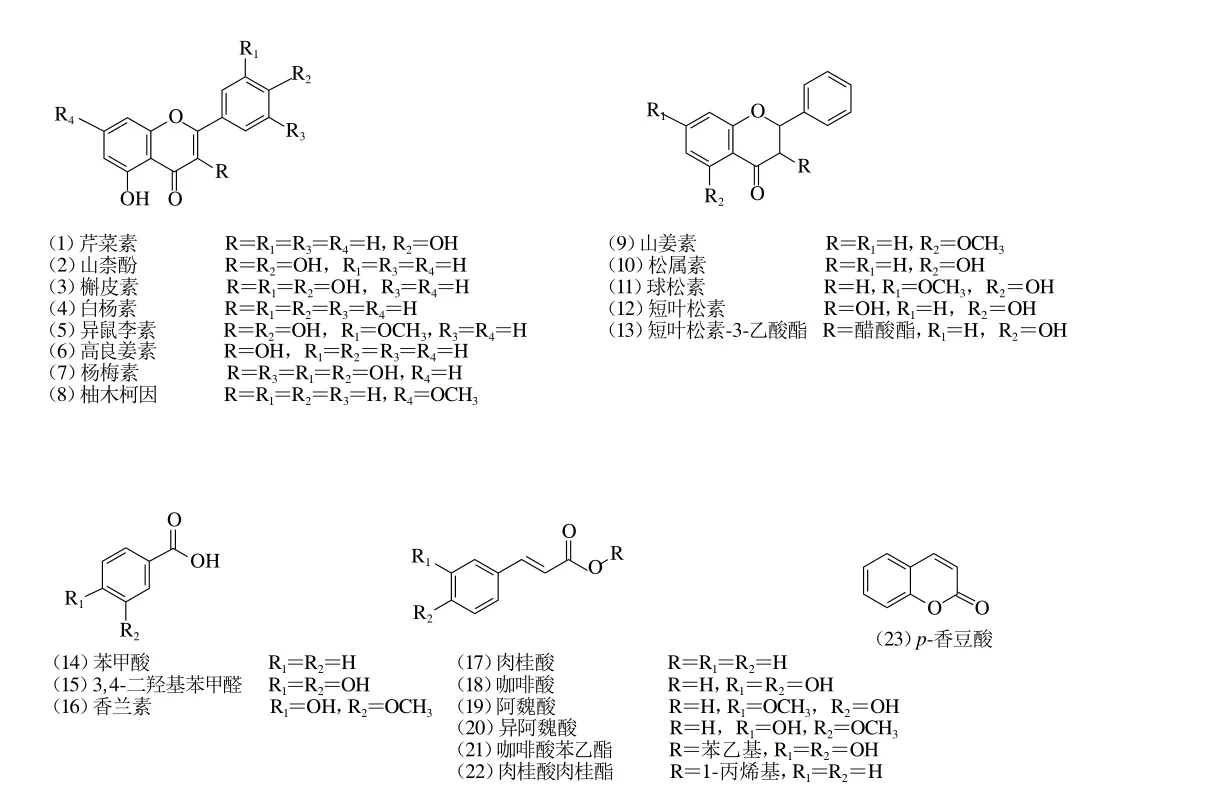
图1 蜂胶中的主要黄酮类化合物、酚酸及酯类化合物的化学结构[24]Fig. 1 Chemical structures of major flavonoids and phenolic acids in propolis[24]
1.2 网络建立及分析
利用开源数据库DAG获取靶标基因与疾病的关联[28]。用Cytoscape3.2.1分析“化合物-疾病-靶点”的关联网络,发现关键成分及靶点。基于边数设置节点颜色及图形大小。
1.3 疾病通路分析
利用开源数据库String10.0分析靶标蛋白的相互作用网络[29]。通过KEGG pathway enrichment算法发现蛋白所在疾病通路,获取P<1×10-4的代谢性疾病相关疾病通路作为重要通路进行进一步分析。
1.4 靶标预测成功率分析
对于预测有潜在作用靶标的成分,通过PubMed文献检索获取其在真实实验中的数据。被成功预测的靶标为Gpr;未被预测到、但位于Gpr下游的靶标为Gpdr;未被预测到且不是Gpdr的为Gr,则:

2 结果与分析
2.1 蜂胶成分改善代谢性疾病的靶标预测
利用结构相似比对算法,从bindingDB、PDB、ChemBL、DrugBank的数据中发现与蜂胶化合物可能的作用靶标。利用DAG数据库获取靶标基因与疾病的关联,选择与肥胖、糖尿病相关的数据进行分析,建立“成分-靶标-疾病”网络(图2)。根据边数排序,PPARγ、ESR1、ESR2、SIRT1、PTPN1是所有化合物集合潜在作用概率最高的靶标。黄酮类化合物与酚酸及酯类化合物的潜在作用靶标有所不同(表1),PPARγ是其共同的重要靶标,表明这两类化合物虽然都可能有调节糖脂代谢的活性,但其作用机制有所不同,有所协同。
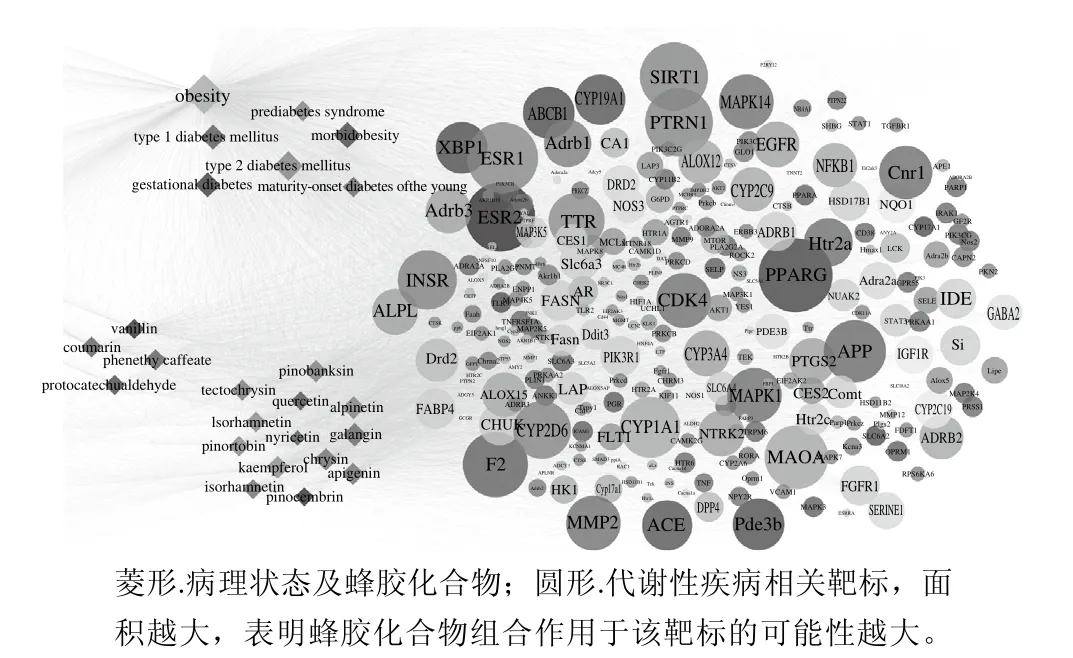
图2 蜂胶成分-靶标-疾病相互作用网络Fig. 2 Chemical-target-disease network
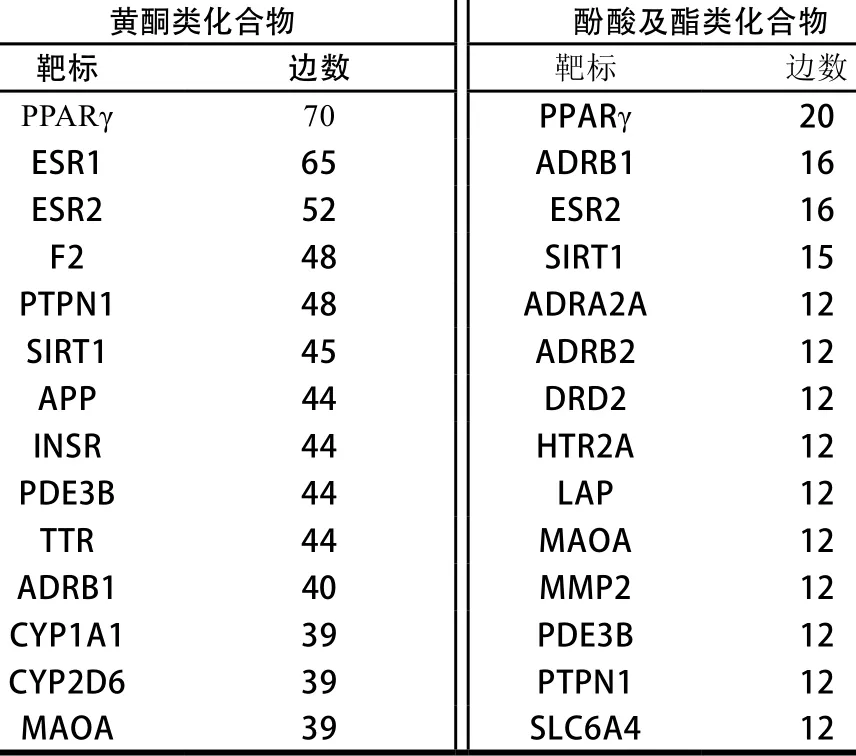
表1 关键靶标析Table 1 Key targets from prediction
2.2 蜂胶成分改善代谢性疾病的主要成分
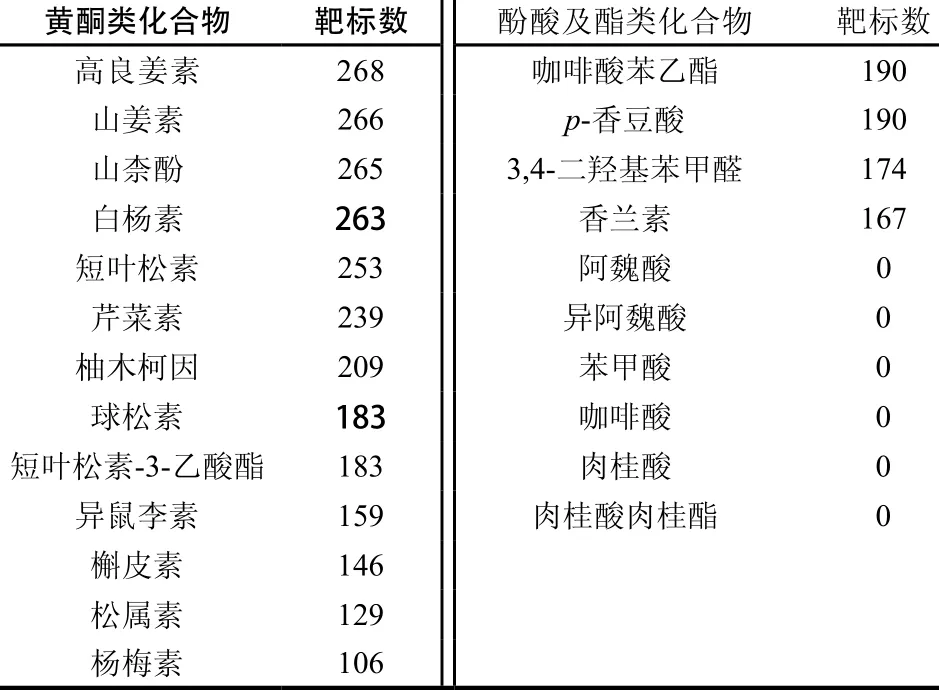
表2 蜂胶化合物对应的糖脂代谢相关靶标数Table 2 The number of predicted targets corresponding to propolis components
由表2可知,在改善代谢性疾病方面,黄酮类化合物比酚酸类化合物有更多的潜在作用靶标,其数目均在100以上。咖啡酸苯乙酯、p-香豆酸、3,4-二羟基苯甲醛和香兰素是主要发挥作用的酚酸类成分,而阿魏酸、异阿魏酸、苯甲酸、咖啡酸、肉桂酸、肉桂酸肉桂酯等酚酸及酯类成分未获取潜在靶标。对于预测有潜在作用靶标的成分,获取其在真实实验中的数据(表3),计算得到靶标预测成功率为86.2%。未能100%预测作用靶标的主要原因在于预测的数据来源于现有数据库,数据库的完整度直接影响方法准确性。此外,现有疾病数据库主要关注病理状态,而对前驱糖尿病等准疾病状态的记录较少。如将蜂胶开发为功能性食品,其主要目标人群应为准疾病状态,虽然现有疾病数据库有一定参考价值,但建设准疾病状态的数据库会大有裨益。
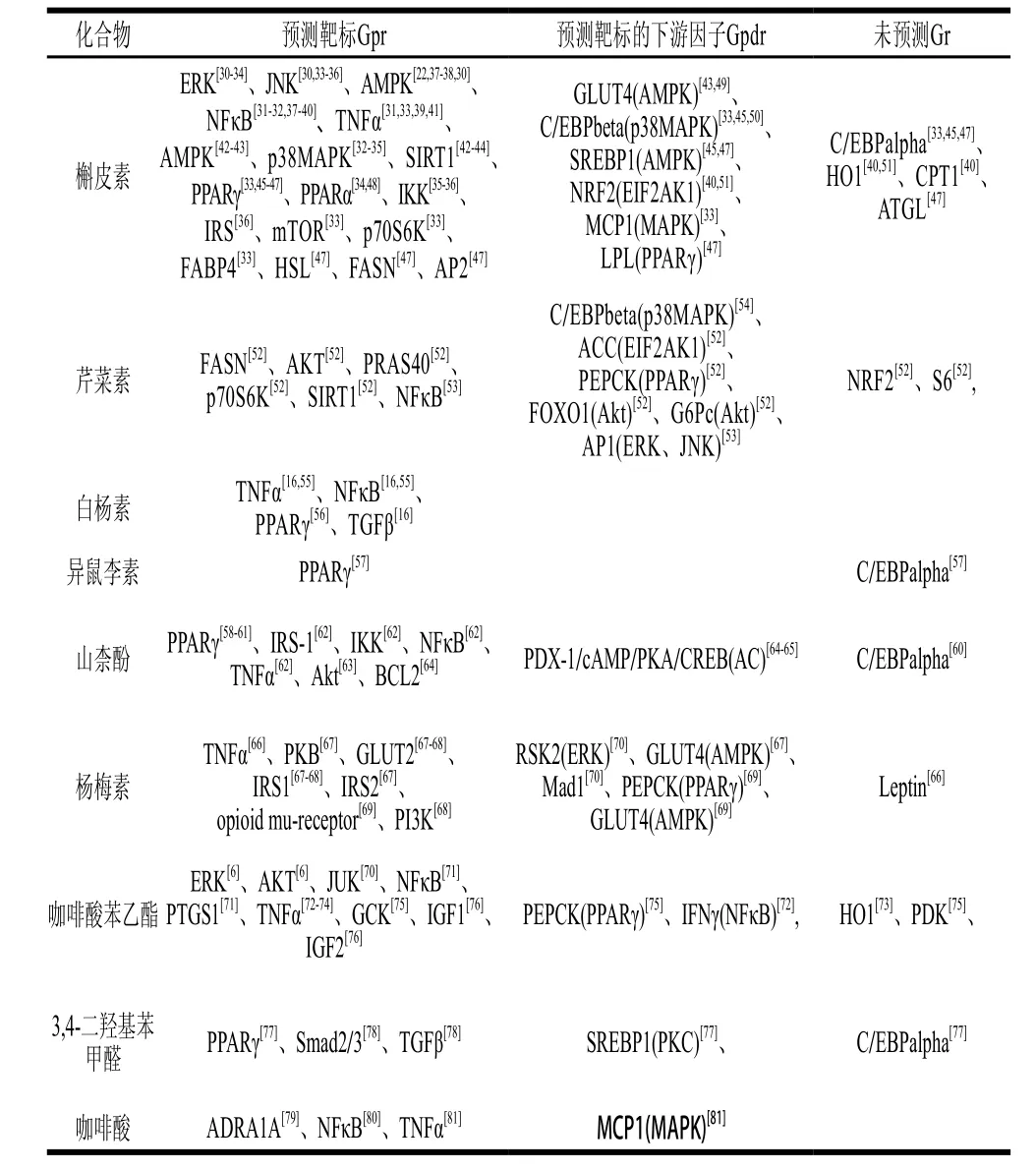
表3 文献报道蜂胶黄酮、酚酸与酯类化合物的作用靶点Table 3 Targets of propolis components searched from PubMed
2.3 蜂胶改善代谢性疾病的生物学通路
利用String 10.0数据库发现224 个与潜在作用靶标对应的人源蛋白,这些蛋白分布于214 条KEGG记载的信号通路上。经Pathway Enrichment计算,发现P<1.00×10-4且与糖脂代谢相关的通路7 条(表4),是蜂胶最可能发挥活性作用的通路。

表4 String预测的KEGG通路Table 4 Enriched KEGG pathway by String prediction
对关键通路进行整合,并按照潜在作用靶标的边数标注颜色(图3)。可知,蜂胶成分可能通过促进糖摄取、促进胰岛素分泌、改善胰岛素抵抗、促进脂代谢、抑制脂肪细胞分化等多种功能改善糖脂代谢过程,从而改善2型糖尿病和肥胖等代谢性疾病;其靶标及活性作用通路根据组织的不同有所差异(表5)。在胰岛素相关通路上,蜂胶成分最可能作用于胰岛素受体及胰岛素样生长因子受体(表6)。
黄酮类化合物和酚酸类化合物是我国蜂胶中含量较为丰富的植物化学物质。本研究通过分子结构相似比对和网络药理学研究发现,蜂胶中的黄酮类化合物改善糖脂代谢的潜在靶点众多,分布于胰岛素分泌、葡萄糖摄取、2型糖尿病、脂肪细胞分化、脂代谢等生理和病理通路。虽然与巴西蜂胶相比,我国蜂胶中不含萜烯类活性成分阿特比林C,但黄酮类化合物的含量是其2 倍,酚酸类化合物的含量也较高,这可能是我国蜂胶与巴西蜂胶相比,辅助降血糖、降血脂[29-82]功效略优的一方面因素。
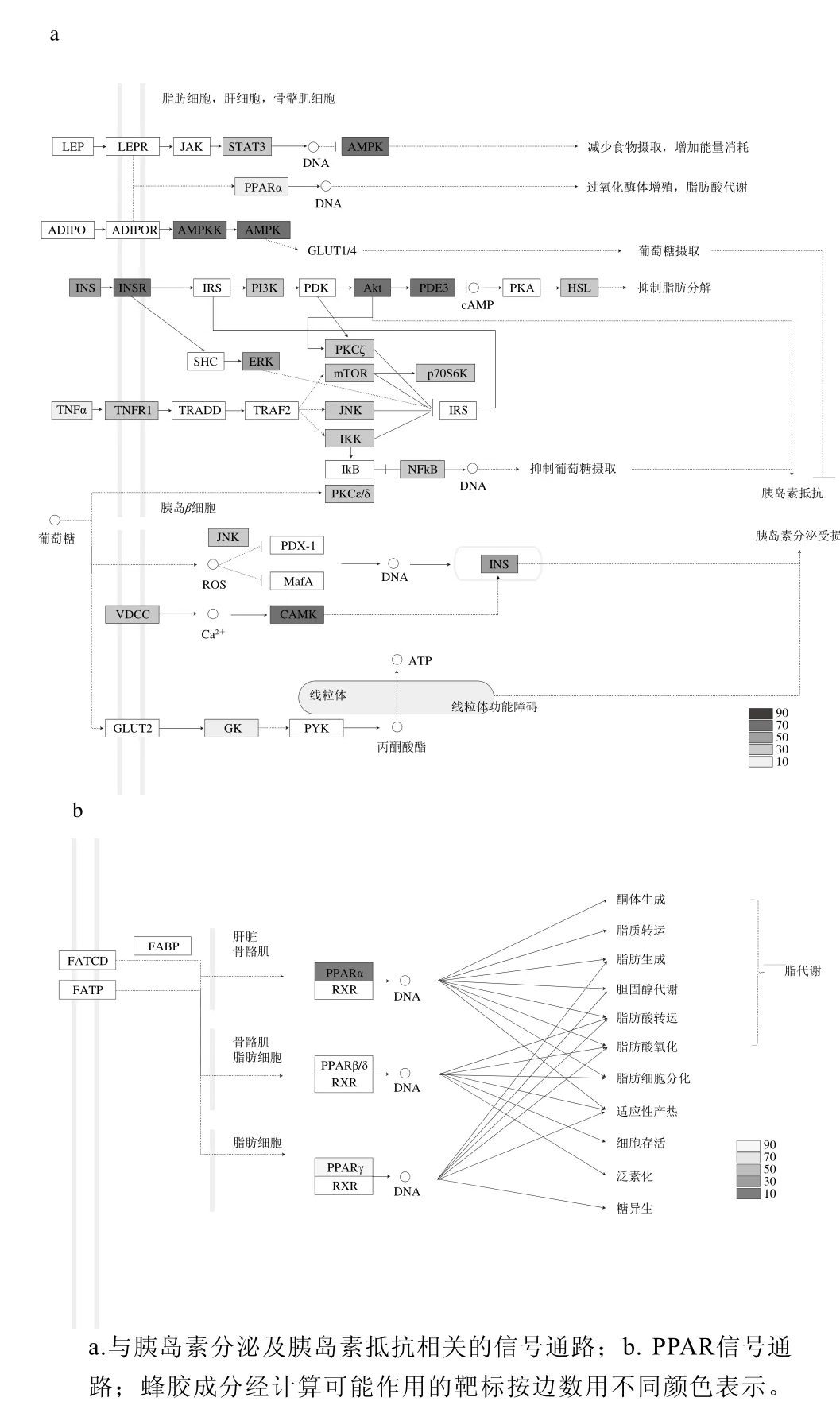
图3 蜂胶成分改善代谢性疾病作用的关键信号通路Fig. 3 Simplified signal pathways in metabolic diseases
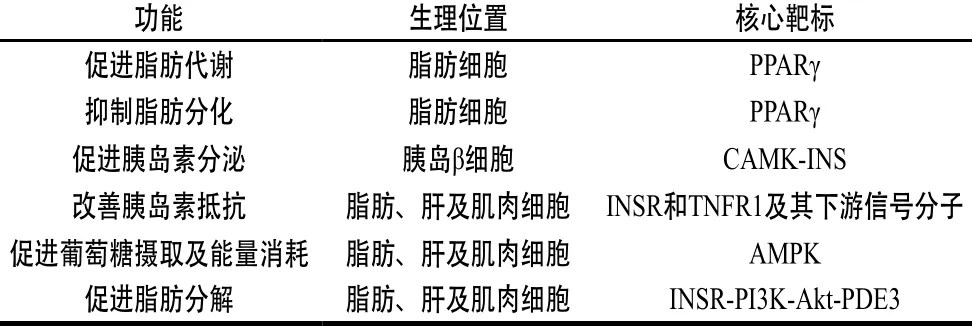
表5 蜂胶成分的关键作用靶点及相关功能Table 5 Predicted key targets and functions of propolis components

表6 蜂胶化合物对胰岛素相关功能的影响Table 6 Effect of propolis components on insulin functions
现阶段我国慢性代谢性疾病发病率高,处于前驱糖尿病等准疾病状态的人群众多。功能性食品作为一种健康生活方式的选择,有助于逆转准疾病的状态。然而,我国功能性食品研究水平较低、生产过程粗放、标准化程度不足,因而无法稳定控制终产品的品质,也就难以确保其健康作用。为了使功能性食品可以有效应用,需要确定其活性成分,了解活性成分的量效关系,基于此制定产品标准,并为标准化生产工艺的开发提供参考,以控制产品质量。本研究以蜂胶为例,将一种可用于预测复杂体系活性组分及其作用机制的方法引入功能性食品研究领域。这一方法的优点在于,在了解目标物品化学成分组成的前提下,不需经过分离、提纯和复杂的活性评价,即能预测其潜在的功能及生物学作用机制,并提示可能的活性成分,为进一步的功能验证、乃至产品标准的制订提供参考。本研究利用现有研究文献数据计算预测成功率,证明该方法有一定的参考价值。
3 结 论
综上所述,本研究利用结构相似比对算法、网络药理学等方法研究蜂胶改善代谢性疾病的生物学机制。结果表明,蜂胶中的黄酮类化合物和部分酚酸及酯类化合物是发挥药理学作用的主要活性成分。这些成分可能分别或者共同作用于促进糖摄取、促进胰岛素分泌、改善胰岛素抵抗、促进脂代谢、抑制脂肪细胞分化等糖脂代谢相关通路,发挥协同作用。PPARγ、ESR1、ESR2、SIRT1、PTPN1是蜂胶化合物总体作用概率最高的靶标。本研究从物质基础和生物学机制两个角度,为开发基于我国蜂胶的、辅助防控代谢性疾病的功能性食品提供了科学依据。
此外,本研究的靶标预测成功率为86.2%,表明结构相似比对结合网络药理学研究手段可以应用于现代化功能性食品研发中对复杂体系的物质基础及生物学机制研究。借助数据库的进一步完善,预测成功率可进一步提升。这一研究思路将有助于促进我国食品行业升级,推动传统药食用物品的再开发。
[1] FUKUDA T, FUKUI M, TANAKA M, et al. Effect of Brazilian green propolis in patients with type 2 diabetes: a double-blind randomized placebo-controlled study[J]. Biomedical Reports, 2015, 3(3): 355-360. DOI:10.3892/br.2015.436.
[2] ZHU Wei, LI yinghua, CHEN Minli, et al. Protective effects of Chinese and Brazilian propolis treatment against hepatorenal lesion in diabetic rats[J]. Human and Experimental Toxicology, 2011, 30(9): 1246-1255. DOI:10.1177/0960327110387456.
[3] KITAMURA H, NAOE y, KIMURA S, et al. Beneficial effects of Brazilian propolis on type 2 diabetes in ob/ob mice: possible involvement of immune cells in mesenteric adipose tissue[J]. Adipocyte, 2013, 2(4): 227-236. DOI:10.4161/adip.25608.
[4] LI yajing, CHEN Minli, XUAN Hongzhuan, et al. Effects of encapsulated propolis on blood glycemic control, lipid metabolism, and insulin resistance in type 2 diabetes mellitus rats[J]. Evidencebased Complementary and Alternative Medicine, 2012, 2012: 981896. DOI:10.1155/2012/981896.
[5] ZAMAMI y, FUJIWARA H, HOSODA M, et al. Ameliorative effect of propolis on insulin resistance in Otsuka Long-Evans Tokushima Fatty (OLETF) rats[J]. Journal of the Pharmaceutical Society of Japan, 2010, 130(6): 833-840.
[6] SHIN Seungho, SEO Sanggwon, MIN Soyun, et al. Caffeic acid phenethyl ester, a major component of propolis, suppresses high fat diet-induced obesity through inhibiting adipogenesis at the mitotic clonal expansion stage[J]. Journal of Agricultural and Food Chemistry, 2014, 62(19): 4306-4312. DOI:10.1021/jf405088f.
[7] WASHIO K, SHIMAMOTO y, KITAMURA H. Brazilian propolis extract increases leptin expression in mouse adipocytes[J]. Biomedical Research, 2015, 36(5): 343-346. DOI:10.2220/biomedres.36.343.
[8] 杨明, 隋殿军, 陈文学, 等. 蜂胶总黄酮对四氧嘧啶糖尿病大鼠降血糖作用[J]. 中国药学杂志, 2014(16): 1410-1413.
[9] KANG Lijun, LEE H B, BAE H J, et al. Antidiabetic effect of propolis: reduction of expression of glucose-6-phosphatase through inhibition of y279 and y216 autophosphorylation of GSK-3alpha/beta in HepG2 cells[J]. Phytotherapy Research, 2010, 24(10): 1554-1561. DOI:10.1002/ptr.3147.
[10] HU Fuliang, HEPBURN H R, XUAN Hongzhuan, et al. Effects of propolis on blood glucose, blood lipid and free radicals in rats with diabetes mellitus[J]. Pharmacological Research, 2005, 51(2): 147-152. DOI:10.1016/j.phrs.2004.06.011.
[11] BABATUNDE I, ABDULBASIT A, OLADAyO M I, et al. Hepatoprotective and pancreatoprotective properties of the ethanolic extract of nigerian propolis[J]. Journal of Intercultural Ethnopharmacology, 2015, 4(2): 102-108. DOI:10.5455/ jice.20150202023615.
[12] El-SAyED S, ABO-SALEM O, ALy H, et al. Potential antidiabetic and hypolipidemic effects of propolis extract in streptozotocin-induced diabetic rats[J]. Pakistan Journal of Pharmaceutical Sciences, 2009, 22(2): 168-174.
[13] MATSUSHIGE K, BASNET P, HASE K, et al. Propolis protects pancreatic beta-cells against the toxicity of streptozotocin (STZ)[J]. Phytomedicine, 1996, 3(2): 203-209. DOI:10.1016/s0944-7113(96)80037-7.
[14] 杨明, 隋殿军, 陈文学, 等. 蜂胶总黄酮对STZ诱导糖尿病大鼠降血糖机制研究[J]. 中药材, 2014, 37(9): 1623-1626. DOI:10.13863/ j.issn1001-4454.2014.09.030.
[15] 张跃. 蜂胶降血糖有效部位化学成分研究[D]. 长春: 吉林农业大学, 2012: 12.
[16] AHAD A, GANAI A A, MUJEEB M, et al. Chrysin, an antiinf l ammatory molecule, abrogates renal dysfunction in type 2 diabetic rats[J]. Toxicology and Applied Pharmacology, 2014, 279(1): 1-7. DOI:10.1016/j.taap.2014.05.007.
[17] CHOI S, CHA B y, IIDA K, et al. Artepillin C, as a PPARgamma ligand, enhances adipocyte differentiation and glucose uptake in 3T3-L1 cells[J]. Biochemical Pharmacology, 2011, 81(7): 925-933. DOI:10.1016/j.bcp.2011.01.002.
[18] OKUTAN H, OZCELIK N, yILMAZ R, et al. Effects of caffeic acid phenethyl ester on lipid peroxidation and antioxidant enzymes in diabetic rat heart[J]. Clinical Biochemistry, 2005, 38(2): 191-196. DOI:10.1016/j.clinbiochem.2004.10.003.
[19] RAJENDRAN P, RENGARAJAN T, NANDAKUMAR N, et al. Kaempferol, a potential cytostatic and cure for inf l ammatory disorders[J]. European Journal of Medicinal Chemistry, 2014, 86: 103-112. DOI:10.1016/j.ejmech.2014.08.011.
[20] UEDA M, HAyASHIBARA K, ASHIDA H. Propolis extract promotes translocation of glucose transporter 4 and glucose uptake through both PI3K- and AMPK-dependent pathways in skeletal muscle[J]. Biofactors, 2013, 39(4): 457-466. DOI:10.1002/biof.1085.
[21] 南垚, 郭伽, 郑莲香, 等. 蜂胶化学成分研究进展[J]. 世界科学技术, 2006, 8(1): 61-71; 56.
[22] 张楠楠, 吴健全, 高蔚娜, 等. 不同产地蜂胶改善糖尿病大鼠氧化应激功效的比较研究[J]. 中国食品卫生杂志, 2014(1): 23-26.
[23] ZHANG Shoude, SHAN Lei, LI Qiao, et al. Systematic analysis of the multiple bioactivities of green tea through a network pharmacology approach[J]. Evidence Based Complementary and Alternative Medicine, 2014, 2014: 512081. DOI:10.1155/2014/512081.
[24] 罗照明, 张红城. 中国蜂胶化学成分及其生物活性的研究[J]. 中国蜂业中旬刊(学术), 2012, 62(2): 55-62.
[25] GONG Jianyu, CAI Chaoqian, LIU Xiaofeng, et al. ChemMapper: a versatile web server for exploring pharmacology and chemical structure association based on molecular 3D similarity method[J]. Bioinformatics, 2013, 29(14): 1827-1829. DOI:10.1093/ bioinformatics/btt270.
[26] LIU Xiaofeng, JIANG Hualiang, LI Honglin. SHAFTS: a hybrid approach for 3D molecular similarity calculation. 1. Method and assessment of virtual screening[J]. Journal of Chemical Information and Modeling, 2011, 51(9): 2372-2385. DOI:10.1021/ci200060s.
[27] LU Weiqiang, LIU Xiaofeng, CAO Xianwen, et al. SHAFTS: a hybrid approach for 3D molecular similarity calculation. 2. Prospective case study in the discovery of diverse p90 ribosomal S6 protein kinase 2 inhibitors to suppress cell migration[J]. Journal of Medicinal Chemistry, 2011, 54(10): 3564-3574. DOI:10.1021/jm200139j.
[28] SZKLARCZyK D, FRANCESCHINI A, WyDER S, et al. STRING v10: protein-protein interaction networks, integrated over the tree of life[J]. Nucleic Acids Research, 2015, 43: D447-D452. DOI:10.1093/ nar/gku1003.
[29] 朱威. 中国蜂胶和巴西蜂胶改善糖尿病大鼠的效果及对糖尿病肾病的作用机理[D]. 杭州: 浙江大学, 2010: 12.
[30] AHN J, LEE H, KIM S, et al. The anti-obesity effect of quercetin is mediated by the AMPK and MAPK signaling pathways[J]. Biochemical and Biophysical Research Communications, 2008, 373(4): 545-549. DOI:10.1016/j.bbrc.2008.06.077.
[31] INDRA M R, KARyONO S K, RATNAWATI R, et al. Quercetin suppresses inflammation by reducing ERK1/2 phosphorylation and NF kappa B activation in Leptin-induced Human Umbilical Vein Endothelial Cells (HUVECs)[J]. BMC Research Notes, 2013, 6: 275. DOI:10.1186/1756-0500-6-275.
[32] LE N H, KIM C S, PARK T, et al. Quercetin protects against obesityinduced skeletal muscle inflammation and atrophy[J]. Mediators of Inf l ammation, 2014: 834294. DOI:10.1155/2014/834294.
[33] SEO M J, LEE y J, HWANG J H, et al. The inhibitory effects of quercetin on obesity and obesity-induced inf l ammation by regulation of MAPK signaling[J]. The Journal of Nutritional Biochemistry, 2015, 26(11): 1308-1316. DOI:10.1016/j.jnutbio.2015.06.005.
[34] yOUL E, MAGOUS R, CROS G, et al. MAP Kinase cross talks in oxidative stress-induced impairment of insulin secretion. Involvement in the protective activity of quercetin[J]. Fundamental and Clinical Pharmacology, 2014, 28(6): 608-615. DOI:10.1111/fcp.12078.
[35] NOH H, KIM C, KANG J, et al. Quercetin suppresses MIP-1alphainduced adipose inf l ammation by downregulating its receptors CCR1/ CCR5 and inhibiting inf l ammatory signaling[J]. Journal of Medicinal Food, 2014, 17(5): 550-557. DOI:10.1089/jmf.2013.2912.
[36] OVERMAN A, CHUANG C C, MCINTOSH M K. Quercetin attenuates inflammation in human macrophages and adipocytes exposed to macrophage-conditioned media[J]. International Journal of Obesity, 2011, 35(9): 1165-1172. DOI:10.1038/ijo.2010.272.
[37] CHEN Pin, CHEN Jingbo, CHEN Wenyu, et al. Effects of quercetin on nuclear factor-kappaB p65 expression in renal ubiquitin-proteasome system of diabetic rats[J]. Chinese Journal of Internal Medicine, 2012, 51(6): 460-465.
[38] KOBORI M, TAKAHASHI y, SAKURAI M, et al. Quercetin suppresses immune cell accumulation and improves mitochondrial gene expression in adipose tissue of diet-induced obese mice[J]. Molecular Nutrition and Food Research, 2015, 60(2): 300-312. DOI:10.1002/mnfr.201500595.
[39] MAHMOUD M, HASSAN N, El-BASSOSSy H, et al. Quercetin protects against diabetes-induced exaggerated vasoconstriction in rats: effect on low grade inf l ammation[J]. PLoS ONE, 2013, 8(5): e63784. DOI:10.1371/journal.pone.0063784.
[40] PANCHAL S, POUDyAL H, BROWN L. Quercetin ameliorates cardiovascular, hepatic, and metabolic changes in diet-induced metabolic syndrome in rats[J]. The Journal of Nutrition, 2012, 142(6): 1026-1032. DOI:10.3945/jn.111.157263.
[41] CHUANG C, MARTINEZ K, XIE G X, et al. Quercetin is equally or more effective than resveratrol in attenuating tumor necrosis factor-{alpha}-mediated inflammation and insulin resistance in primary human adipocytes[J]. The American Journal of Clinical Nutrition, 2010, 92(6): 1511-1521. DOI:10.3945/ajcn.2010.29807.
[42] DONG Jing, ZHANG Xian, ZHANG Lei, et al. Quercetin reduces obesity-associated ATM infiltration and inflammation in mice: a mechanism including AMPKalpha1/SIRT1[J]. Journal of Lipid Research, 2014, 55(3): 363-374. DOI:10.1194/jlr.M038786.
[43] EID H, NACHAR A, THONG F, et al. The molecular basis of the antidiabetic action of quercetin in cultured skeletal muscle cells and hepatocytes[J]. Pharmacognosy Magazine, 2015, 11(41): 74-81. DOI:10.4103/0973-1296.149708.
[44] ZHAO Lirong, DU yujun, CHEN Lei, et al. Quercetin protects against high glucose-induced damage in bone marrow-derived endothelial progenitor cells[J]. International Journal of Molecular Medicine, 2014, 34(4): 1025-1031. DOI:10.3892/ijmm.2014.1852.
[45] ESEBERRI I, MIRANDA J, LASA A, et al. Doses of quercetin in the range of serum concentrations exert delipidating effects in 3T3-L1 preadipocytes by acting on different stages of adipogenesis, but not in mature adipocytes[J]. Oxidative Medicine and Cellular Longevity, 2015, 2015: 480943. DOI:10.1155/2015/480943.
[46] JUNG C, CHO I, AHN J, et al. Quercetin reduces high-fat diet-induced fat accumulation in the liver by regulating lipid metabolism genes[J]. Phytotherapy Research, 2013, 27(1): 139-143. DOI:10.1002/ptr.4687.
[47] SEO y, KANG O, KIM S, et al. Quercetin prevents adipogenesis by regulation of transcriptional factors and lipases in OP9 cells[J]. International Journal of Molecular Medicine, 2015, 35(6): 1779-1785. DOI:10.3892/ijmm.2015.2185.
[48] KOBORI M, MASUMOTO S, AKIMOTO y, et al. Chronic dietary intake of quercetin alleviates hepatic fat accumulation associated with consumption of a Western-style diet in C57/BL6J mice[J]. Molecular Nutrition and Food Research, 2011, 55(4): 530-540. DOI:10.1002/ mnfr.201000392.
[49] ALAM M, MEERZA D, NASEEM I. Protective effect of quercetin on hyperglycemia, oxidative stress and DNA damage in alloxan induced type 2 diabetic mice[J]. Life Sciences, 2014, 109(1): 8-14. DOI:10.1016/j.lfs.2014.06.005.
[50] SHIMIZU M, LI J, INOUE J, et al. Quercetin represses apolipoprotein B expression by inhibiting the transcriptional activity of C/EBPbeta[J]. PLoS ONE, 2015, 10(4): e0121784. DOI:10.1371/journal.pone.0121784.
[51] KIM C, KWON y, CHOE S, et al. Quercetin reduces obesity-induced hepatosteatosis by enhancing mitochondrial oxidative metabolism via heme oxygenase-1[J]. Nutrition and Metabolism, 2015, 12: 33. DOI:10.1186/s12986-015-0030-5.
[52] BUMKE-VOGT C, OSTERHOFF M A, BORCHERT A, et al. The fl avones apigenin and luteolin induce FOXO1 translocation but inhibit gluconeogenic and lipogenic gene expression in human cells[J]. PLoS ONE, 2014, 9(8): e104321. DOI:10.1371/journal.pone.0104321.
[53] SUH K S, OH S, WOO J T, et al. Apigenin attenuates 2-deoxy-D-ribose-induced oxidative cell damage in HIT-T15 pancreatic betacells[J]. Biological and Pharmaceutical Bulletin, 2012, 35(1): 121-126.
[54] KIM M A, KANG K, LEE H J, et al. Apigenin isolated from Daphne genkwa Siebold et Zucc. inhibits 3T3-L1 preadipocyte differentiation through a modulation of mitotic clonal expansion[J]. Life Sciences, 2014, 101(1/2): 64-72. DOI:10.1016/j.lfs.2014.02.012.
[55] LI Rui, ZANG Aihua, ZHANG Lei, et al. Chrysin ameliorates diabetes-associated cognitive deficits in Wistar rats[J]. Neurological Sciences, 2014, 35(10): 1527-1532. DOI:10.1007/s10072-014-1784-7. [56] FENG Xiujing, QIN Haohan, SHI Qian, et al. Chrysin attenuates inflammation by regulating M1/M2 status via activating PPARgamma[J]. Biochemical Pharmacology, 2014, 89(4): 503-514. DOI:10.1016/j.bcp.2014.03.016.
[57] LEE J, JUNG E, JIENNy L, et al. Isorhamnetin represses adipogenesis in 3T3-L1 cells[J]. Obesity (Silver Spring), 2009, 17(2): 226-232. DOI:10.1038/oby.2008.472.
[58] ByUN Miran, JEONG Hana, BAE Sujung, et al. TAZ is required for the osteogenic and anti-adipogenic activities of kaempferol[J]. Bone, 2012, 50(1): 364-372. DOI:10.1016/j.bone.2011.10.035.
[59] FANG Xiankang, GAO Jie, ZHU Danni. Kaempferol and quercetin isolated from Euonymus alatus improve glucose uptake of 3T3-L1 cells without adipogenesis activity[J]. Life Sciences, 2008, 82(11/12): 615-622. DOI:10.1016/j.lfs.2007.12.021.
[60] LEE y, CHOI H, SEO M, et al. Kaempferol suppresses lipid accumulation by inhibiting early adipogenesis in 3T3-L1 cells and zebraf i sh[J]. Food and Function, 2015, 6(8): 2824-2833. DOI:10.1039/ c5fo00481k.
[61] PARK U, JEONG J, JANG J, et al. Negative regulation of adipogenesis by kaempferol, a component of Rhizoma Polygonati falcatum in 3T3-L1 cells[J]. Biological and Pharmaceutical Bulletin, 2012, 35(9): 1525-1533.
[62] LUO Cheng, yANG Hui, TANG Chengyong, et al. Kaempferol alleviates insulin resistance via hepatic IKK/NF-kappaB signal in type 2 diabetic rats[J]. International Immunopharmacology, 2015, 28(1): 744-750. DOI:10.1016/j.intimp.2015.07.018.
[63] ZHANG yanling, LIU Dongmin. Flavonol kaempferol improves chronic hyperglycemia-impaired pancreatic beta-cell viability and insulin secretory function[J]. European Journal of Pharmacology, 2011, 670(1): 325-332. DOI:10.1016/j.ejphar.2011.08.011.
[64] ZHANG yanling, ZHEN Wei, MAECHLER P, et al. Small molecule kaempferol modulates PDX-1 protein expression and subsequently promotes pancreatic beta-cell survival and function via CREB[J]. The Journal of Nutritional Biochemistry, 2013, 24(4): 638-646. DOI:10.1016/j.jnutbio.2012.03.008.
[65] ALKHALIDy H, MOORE W, ZHANG y L, et al. Small molecule Kaempferol promotes insulin sensitivity and preserved pancreatic betacell mass in middle-aged obese diabetic mice[J]. Journal of Diabetes Research, 2015, 2015: 532984. DOI:10.1155/2015/532984.
[66] CHOI H, KANG M J, LEE S, et al. Ameliorative effect of myricetin on insulin resistance in mice fed a high-fat, high-sucrose diet[J]. Nutrition Research and Practice, 2014, 8(5): 544-549. DOI:10.4162/ nrp.2014.8.5.544.
[67] KANDASAMy N, ASHOKKUMAR N. Protective effect of bioflavonoid myricetin enhances carbohydrate metabolic enzymes and insulin signaling molecules in streptozotocin-cadmium induced diabetic nephrotoxic rats[J]. Toxicology and Applied Pharmacology, 2014, 279(2): 173-185. DOI:10.1016/j.taap.2014.05.014.
[68] LIU I, TZENG T, LIOU S, et al. Improvement of insulin sensitivity in obese Zucker rats by myricetin extracted from Abelmoschus moschatus[J]. Planta Medica, 2007, 73(10): 1054-1060. DOI:10.1055/ s-2007-981577.
[69] LIU I, LIOU S, CHENG J. Mediation of beta-endorphin by myricetin to lower plasma glucose in streptozotocin-induced diabetic rats[J]. Journal of Ethnopharmacology, 2006, 104(1/2): 199-206. DOI:10.1016/j.jep.2005.09.001.
[70] FENG Jianfang, CHEN Xiaonan, WANG yuanyuan, et al. Myricetin inhibits proliferation and induces apoptosis and cell cycle arrest in gastric cancer cells[J]. Molecular and Cellular Biochemistry, 2015, 408(1/2): 163-170. DOI:10.1007/s11010-015-2492-1.
[71] BEZERRA R M N, VEIGA L F, CAETANO A C, et al. Caffeic acid phenethyl ester reduces the activation of the nuclear factor kappaB pathway by high-fat diet-induced obesity in mice[J]. Metabolism, 2012, 61(11): 1606-1614. DOI:10.1016/j.metabol.2012.04.006.
[72] CELIK S, ERDOGAN S. Caffeic acid phenethyl ester (CAPE) protects brain against oxidative stress and inf l ammation induced by diabetes in rats[J]. Molecular and Cellular Biochemistry, 2008, 312(1/2): 39-46. DOI:10.1007/s11010-008-9719-3.
[73] HASSAN N, El-BASSOSSy H, MAHMOUD M, et al. Caffeic acid phenethyl ester, a 5-lipoxygenase enzyme inhibitor, alleviates diabetic atherosclerotic manifestations: effect on vascular reactivity and stiffness[J]. Chemico-Biological Interactions, 2014, 213: 28-36. DOI:10.1016/j.cbi.2014.01.019.
[74] JUMAN S, yASUI N, IKEDA K, et al. Caffeic acid phenethyl ester suppresses the production of pro-inflammatory cytokines in hypertrophic adipocytes through lipopolysaccharide-stimulated macrophages[J]. Biological and Pharmaceutical Bulletin, 2012, 35(11): 1941-1946.
[75] CELIK S, ERDOGAN S, TUZCU M. Caffeic acid phenethyl ester (CAPE) exhibits significant potential as an antidiabetic and liver-protective agent in streptozotocin-induced diabetic rats[J]. Pharmacological Research, 2009, 60(4): 270-276. DOI:10.1016/ j.phrs.2009.03.017.
[76] PARK S, MIN T. Caffeic acid phenethyl ester ameliorates changes in IGFs secretion and gene expression in streptozotocin-induced diabetic rats[J]. Life Sciences, 2006, 78(15): 1741-1747. DOI:10.1016/ j.lfs.2005.08.011.
[77] KIM J, PARK S, yU M, et al. Effect of Ganoderma applanatum mycelium extract on the inhibition of adipogenesis in 3T3-L1 adipocytes[J]. Journal of Medicinal Food, 2014, 17(10): 1086-1094. DOI:10.1089/jmf.2013.3036.
[78] KIM y S, KIM N H, LEE S W, et al. Effect of protocatechualdehyde on receptor for advanced glycation end products and TGF-beta1 expression in human lens epithelial cells cultured under diabetic conditions and on lens opacity in streptozotocin-diabetic rats[J]. European Journal of Pharmacology, 2007, 569(3): 171-179. DOI:10.1016/j.ejphar.2007.05.054.
[79] CHENG J T, LIU I M, TZENG T F, et al. Release of beta-endorphin by caffeic acid to lower plasma glucose in streptozotocin-induced diabetic rats[J]. Hormone and Metabolic Research, 2003, 35(4): 251-258. DOI:10.1055/s-2003-39482.
[80] NATARELLI L, RANALDI G, LEONI G, et al. Nanomolar caffeic acid decreases glucose uptake and the effects of high glucose in endothelial cells[J]. PLoS ONE, 2015, 10(11): e0142421. DOI:10.1371/journal.pone.0142421.
[81] CHAO C, MONG M, CHAN K, et al. Anti-glycative and antiinflammatory effects of caffeic acid and ellagic acid in kidney of diabetic mice[J]. Molecular Nutrition and Food Research, 2010, 54(3): 388-395. DOI:10.1002/mnfr.200900087.
[82] 王雪梅, 王飞飞, 田海霞, 等. 巴西蜂胶和国产蜂胶乙醇浓缩液对2型糖尿病大鼠糖、脂代谢的影响研究[J]. 糖尿病新世界, 2015(17): 56-59. DOI:10.3969/j.issn.1672-4062.2015.17.025.
Systematic Analysis of Biological Mechanisms of Propolis in Improving Metabolic Health through a Network Pharmacological Approach
YING Jian, ZHANG Bo, WANG Chunbo, WANG Chunling*
(COFCO Nutrition and Health Research Institute, Beijing 102209, China)
Chronic metabolic diseases, such as type 2 diabetes and obesity, have brought a huge burden to our society. Certain functional foods could bring health benef i ts to people with metabolic abnormalities, and sometimes help delay the onset of metabolic diseases. Propolis is a traditional Chinese medicine, and has been used as a raw material of functional foods for quite a long time. Pharmacological studies and clinical trials have provided evidence that propolis and its active components could be promising candidates for improving metabolic health. In order to develop standardized functional foods with consistent quality and functions, a systemic view of the mechanism of action is required. We should also be aware that propolis is a combination of multiple active components. Network pharmacology is a recently developed method as an integrative system which enables a systemic investigation of interactions between multiple components and multiple targets. The method of network pharmacology has been used in studies of traditional Chinese medicine. In order to survey the molecular mechanisms of propolis components in treating metabolic diseases, we use structural similarity search to predict therapeutic targets of propolis fl avonoids, phenolic acids and esters, and to construct a ‘component-target-disease’ network. Comparing with published data, we calculated that the success ratio of prediction was 86.2%. Based on the network, we concluded that PPARγ, ESR1, ESR2, SITR1 and PTPN1 are key targets of propolis. PPARγ is the most important target for both fl avonoids and phenolic acids. Propolis fl avonoids and some phenolic acids and esters contribute to the regulation of glucose and lipid metabolism by propolis through various pathways such as lipid metabolism, adipocyte differentiation, insulin secretion and insulin resistance. Based on the results of our study, we introduced a new research tool that can be used in the early stage of functional food development. We found that network pharmacology could provide information forformulating product standards for functional foods, which is important for innovation and upgrading of food industry.
structural similarity search; network pharmacology; propolis; metabolic diseases; fl avonoids; phenolic acids and esters; prediction ratio
10.7506/spkx1002-6630-201711016
S896
A
1002-6630(2017)11-0095-08引文格式:
2016-04-08
国家高技术研究发展计划(863计划)项目(2014AA021503);北京市科技计划课题(Z161100000616012)
应剑(1984—),女,高级工程师,博士,研究方向为药食用植物研究与开发。E-mail:yingjian@cofco.com
*通信作者:王春玲(1972—),女,高级工程师,博士,研究方向为营养科学。E-mail:wangchunling@cofco.com

